Photo of the day: Near-Miss Reporting and Posters
Employee participation in any near-miss program is vital, however, it can be challenging to get workers to conform to change especially when it can be time-consuming or seem unnecessary. All workers regardless of their role have a long list of tasks to complete on a daily/weekly basis, how can you make near-miss reporting quick and easy to lodge to ensure workers can continue with their day?
in the photo of today and the below article you will learn the following:
- What is a near miss?
- Why should we track near misses?
- What are the key components in near-miss reporting?
- How do we encourage near-miss reporting?
- 5 free Near-MIss Posters
Also Read the Photo of the day:5-Signs your Near-Miss Reporting is failing
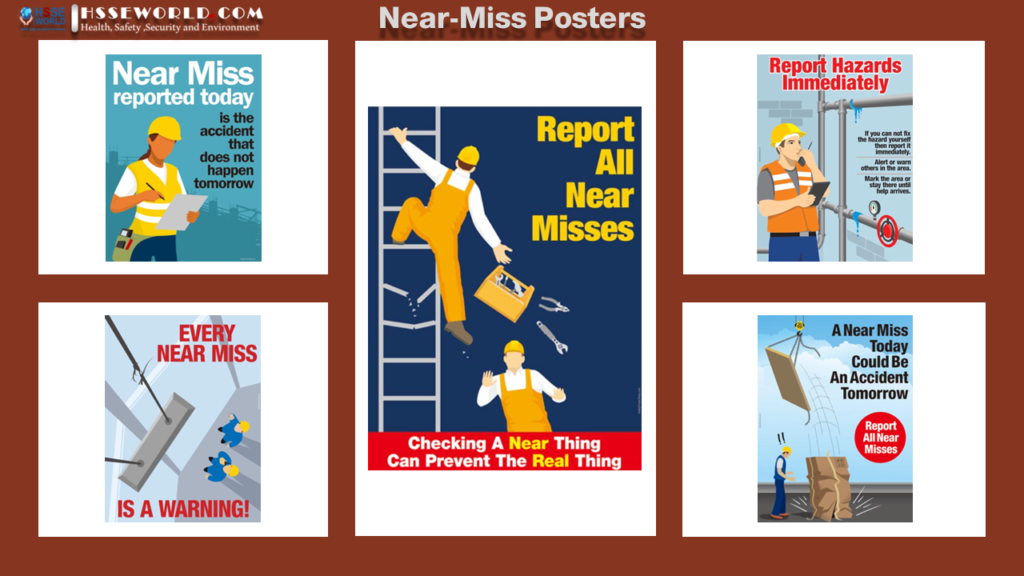
What is a near miss?
A near miss is an unplanned event that did not result in any injury, illness, or damage, but had the potential to do so.
In one instance, an assistant cook was pulled aside just in time from the scalding hot liquid by his colleague a female chef with superhuman reflexes. She saved the day (and his life) by preventing slips, and catching falling and flying objects.
other Standard defines a near miss as an unplanned event that did not result in any injury, illness, or damage but had the potential to do so. When the sequence of events that could lead to an accident is interrupted by chance, it prevents any harm or loss from taking place.
Also Read: Ergonomics Near Misses
Why should we track near misses?
Managing near-miss events can help you avoid future accidents from taking place.
Near misses happen in all companies regardless of their industry or scale of operation. Hence, all companies can tap on the benefits of near-miss reporting to give their HSE journey a boost. The many benefits are described below but ultimately, the main desired outcome is to prevent all injuries and ill-health at work.
Also Read : Photo of the day: Tracking Near Miss Incidents
Proactive monitoring
Some companies use near misses as a leading indicator of their HSE performance. Near misses can be thought of as symptoms of an undiscovered problem at the workplace. It can occur repeatedly before an accident finally happens. Hence, it is a leading indicator, amongst other safety performance indicators, you should take advantage of. Other safety performance indicators include, but are not limited to, incident trends, medical leave trends, inspection findings, audit findings, and employee feedback. Companies usually wait for an accident to happen before taking corrective action. By tracking near misses, they can take pre-emptive action before an accident happens
Zero-cost lesson
Near miss, events do not result in personal harm or property damage. By tracking, analyzing, and managing reported near misses, companies can learn from these zero-cost lessons and make improvements.
Conversely, acting only after sustaining injuries or damages creates a major hurdle. Every accident will bring about devastating loss and incur massive expenses that will interfere with daily operations. Furthermore, the company has to spend additional resources to prevent a similar accident from happening in the future.
Therefore, it makes better business sense to work with near misses to uncover and arrest hazards at the onset before they escalate to outcomes that are beyond control.
Preventive action

Figure 1 shows an accident pyramid adapted from Heinrich’s study of workplace accidents. Heinrich observed that for every accident that results in a major injury, there would be 29 accidents with minor injuries, and 300 near misses (i.e., in a ratio of 1:29:300). Although other studies conducted based on Heinrich’s theory presented different ratios, the general rule remained near misses always occur in larger numbers than accidents.
From Heinrich’s observation, it is clear that a hazard can manifest its presence through near misses. Companies should recognize that near misses provide the opportunity to identify workplace hazards. Accidents can be prevented once hazards are known and prompt your company to take action to eliminate or mitigate the hazard.
Culture building
Near miss, reporting can be a means to engage and empower all your employees. It can help your company improve its communication channels and environment. On top of that, it can foster an open WSH culture where everyone shares and contributes in a responsible manner to improve safety and health for themselves and their fellow workers.
Also read: Close calls and Near misses incidents
What are the key components in near-miss reporting?
There is no need to set up a dedicated system for near-miss reporting. You can achieve the same outcome by revising your existing safety management system criteria to include near misses. Companies that are new to a reporting culture can refer to the description of the key components in near-miss reporting in Figure 2.

Identify
Employees need to understand how to properly identify and recognize near-miss events. One method of training is to involve employees in job safety analysis or risk assessment that will highlight potential hazards in their work areas. This is extremely important as it will affect the quality of the near-miss reports turned in.
In the earlier stages, while employees are still beginning to understand the concept of near misses, the quality of the reports may vary. But over time, you can use past reports to fine-tune their understanding of your company’s definition of a near-miss event.
Report
A complicated procedure and overly-detailed reports would discourage staff. Ensure that the process for reporting near misses is hassle-free and easy to understand. The form for reporting should be kept as simple as possible. Dates, location, and general description of the near-miss incident are key information to include in the form. See attachment for a template of a near-miss report
Also Read: Reporting Near-Misses
Investigate
When conducting an investigation, you should not only look at what had happened but also probe further into what could have happened. Evaluate the possible consequences of the reported near miss and rank it by its potential severity and likelihood of occurrence. This is similar to how risks are assessed in a risk matrix.
Read more about risk matrices in Risk Management.
If major injuries or fatalities are likely, a full investigation is encouraged. If the potential consequences were less severe, the hazard can be easily taken care of and communicated to everyone.
Using the investigation findings, intervention efforts can be prioritized accordingly and the risk management system reviewed. Guidance on conducting investigations can be found Accident-Incident Investigation Technique guideline
Intervene
The staff working in the area where the near-miss took place should rectify the problem because they are most familiar with the worksite. Interventions can take place before and after an investigation. Encourage your employees to take action to temporarily mitigate the danger before investigations start. After completing investigations, permanent solutions can be implemented
Review
The data collected from near misses are leading indicators of your company’s WSH performance. Use it together
with other HSE safety performance indicators in your evaluation. The review can be done on a daily, weekly, or monthly basis to identify trends and provide solutions to remove the hazard. Reviewing and analyzing the data is an opportunity to gather feedback on performance and enhance your workplace safety.
How do we encourage near-miss reporting?
Employees’ participation is vital for near-miss reporting to succeed. Therefore, we need to educate them on why near-miss reporting is necessary. Employees should also understand that they play a crucial role in the process of reporting. These must be communicated and positively reinforced to all employees across all levels.
Here are some good practices that would encourage employees to participate in near-miss reporting.
No-blame culture
Reassure your employees that the information being collected will be used to learn and improve—not to blame or punish. To improve the quality of report submission, you can consider anonymous reporting. Employees would be more comfortable with sharing information when their identities are kept confidential. However, this could hinder information gathering during the investigation when assistance from reporting employees may be needed.
It is important to earn your employees’ trust when it comes to reporting. An environment where employees feel comfortable coming forward without any fear of repercussion would make the near-miss reporting system a success.
Empower employees
All employees should be empowered to spot and fix hazards at their own discretion before near misses escalate into more severe consequences. Employees usually hesitate to take action because they are unsure if it is their responsibility to do so.
Establish clear responsibilities for your employees and encourage them to cooperate and actively contribute in providing solutions.
Communication
Communication is key in promoting near-miss reporting among employees. Regular and consistent communication will help to sustain the interest in to report. Combining open communication with a no-blame policy will let employees feel that their suggestions are valued.
Besides highlighting the benefits of near-miss reporting, communication is also about sharing near misses that employees could relate to. The sharing can be carried out by supervisors or top management to demonstrate their commitment to the well-being of their employees.
Create a culture of reporting
To establish a strong reporting culture, you should act on every opportunity to identify and control hazards, reduce risk and prevent harmful incidents. The senior management can begin by creating a policy and communicating it to all employees. The support from middle management such as managers and supervisors is vital as they work closely with the workers. Middle management managers should be role models for their subordinates and set a good example to propagate the value of near-miss reporting. Besides including near-miss reporting into the job scope of employees, you may also consider providing training on near-miss reporting for new employees as part of their orientation.
To cultivate the habit of submitting near-miss reports or collecting adequate data for analysis, you may be tempted to set quotas. Although quota-setting may help set a clearer target and expectations for a new reporting program, it could also dilute the quality of the information you receive. If made compulsory, employees may submit reports for the sake of meeting the quota, and not out of genuine concern for safety. Employees who met their quota for that period of time may also choose to stop reporting; hence some near misses would not be identified.
Easy to understand and use
A complicated or confusing process will likely discourage employees from reporting. Therefore, it is important to ensure that the reporting process is easy to understand and implement.
The form should be kept concise and questions straightforward so employees can easily learn how to use them. Lastly, obtaining the forms should also be convenient so employees can record and submit a report readily.
Feedback
Staff should be made aware of actions that are taken in response to reported near misses. It can be shared at company meetings and project sites via platforms such as toolbox meetings.
Feedback motivates employees to do near-miss reporting as they can see that their suggestions are valued and help shape their workplace. In the event that more time is needed to rectify the condition, feedback will also reassure employees that their contributions are not being overlooked.
Incentives
One possible method to promote and encourage near-miss reporting is to offer incentives to employees. An example of a good incentive is one that recognizes the participation of employees in the recognition and reporting of hazards. For instance, giving due credit to employees who had submitted reports helped avert potentially disastrous accidents.
Acknowledging contribution from your staff helps to nurture a stronger reporting culture and better engage employees in purposeful WSH activities. ( Download : Templates: HSE Incentives and rewards )
An example of a poor incentive is one that measures performance by placing focus on statistics and setting numerical targets. This will have a negative impact on the reporting culture because the driving force behind reporting is to meet targets.
Near-MIss Posters
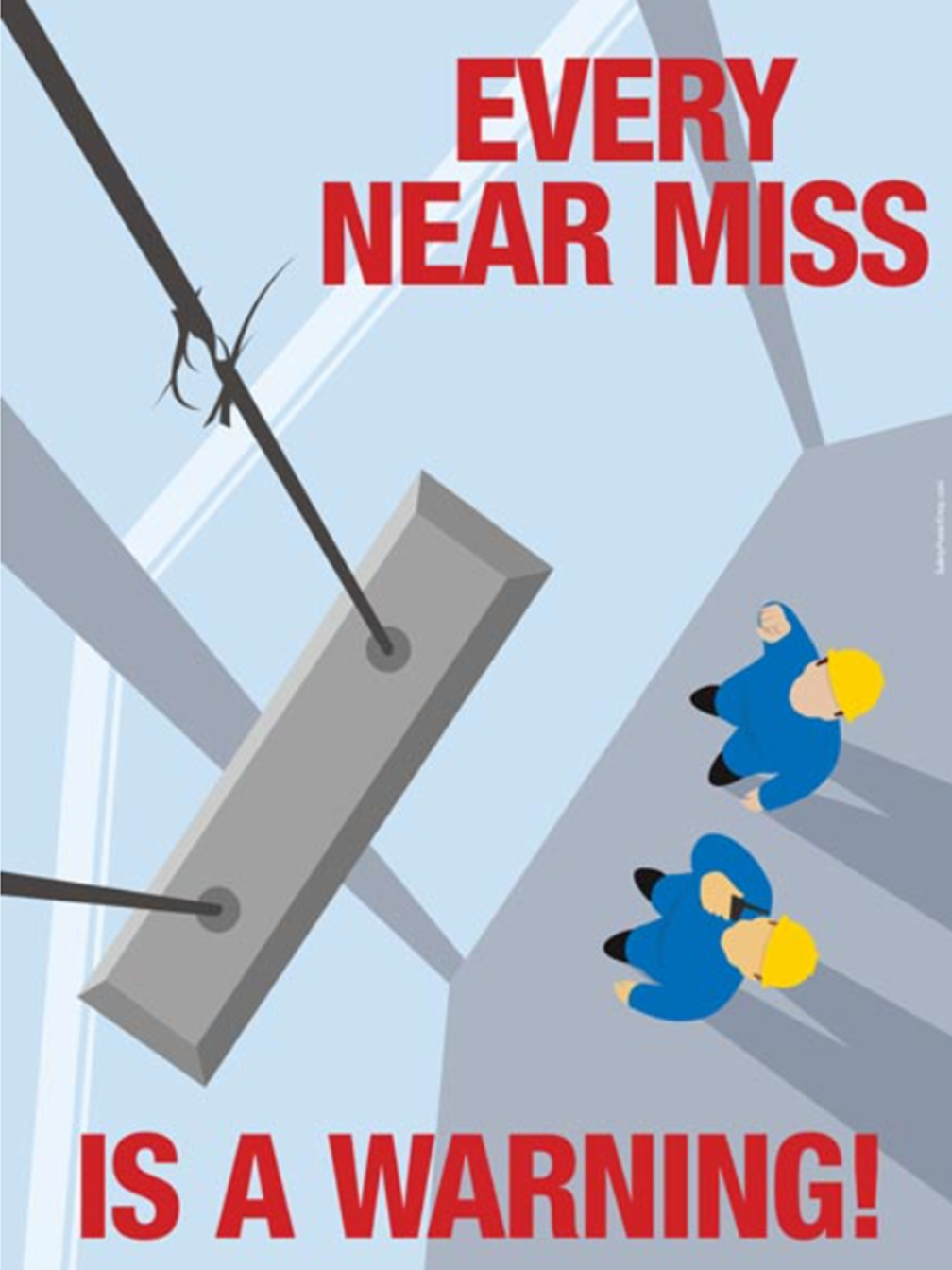
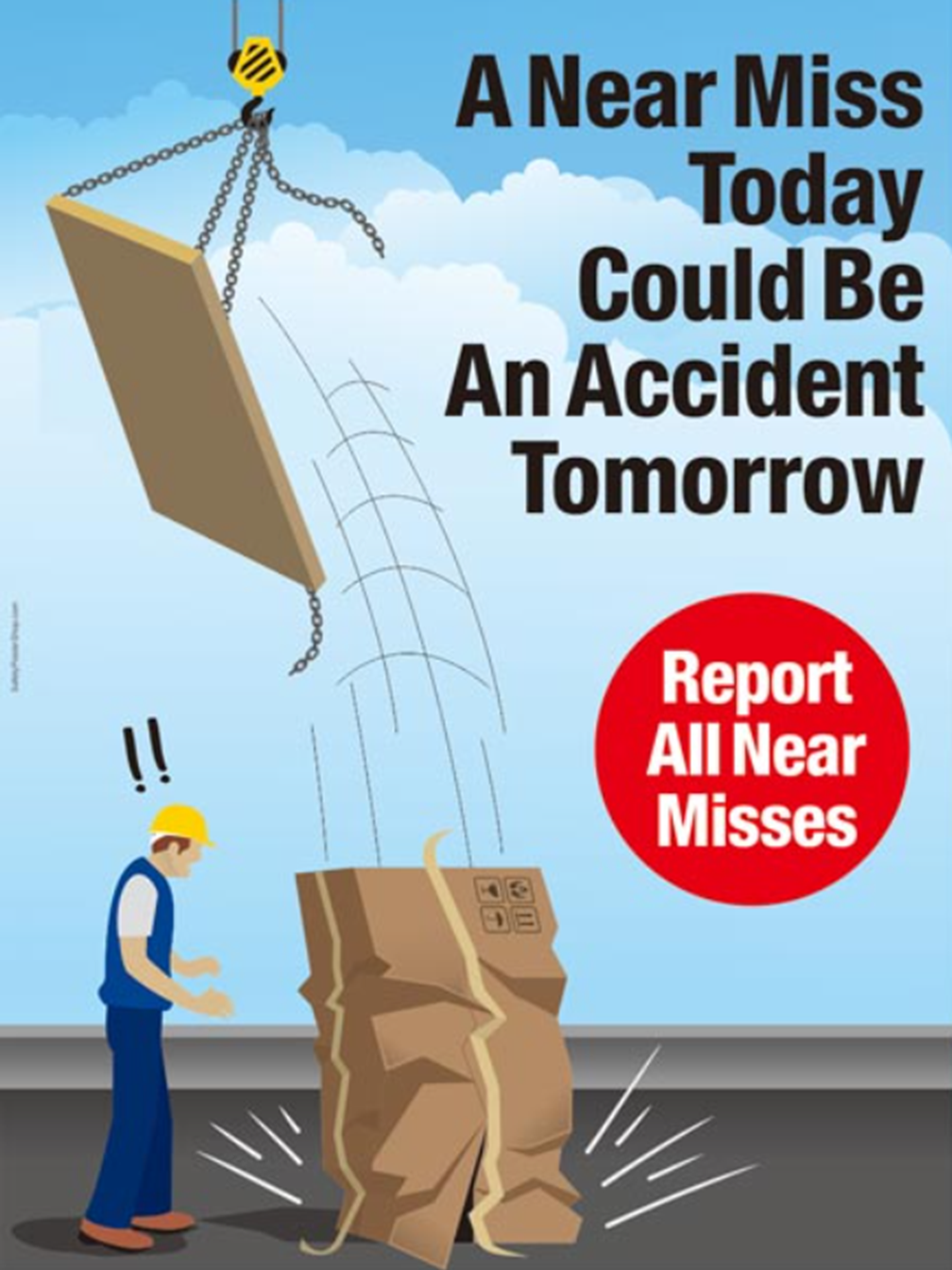
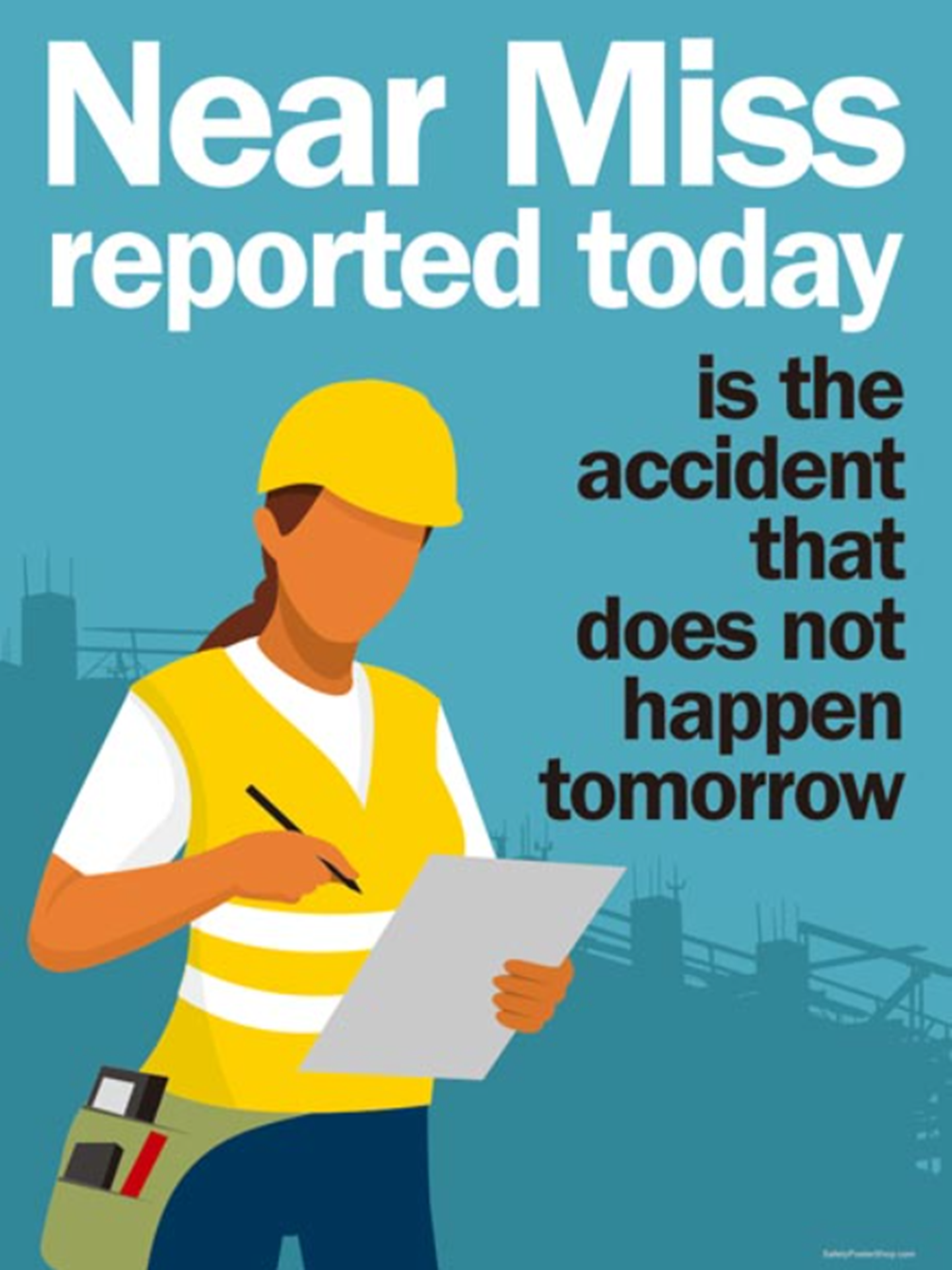
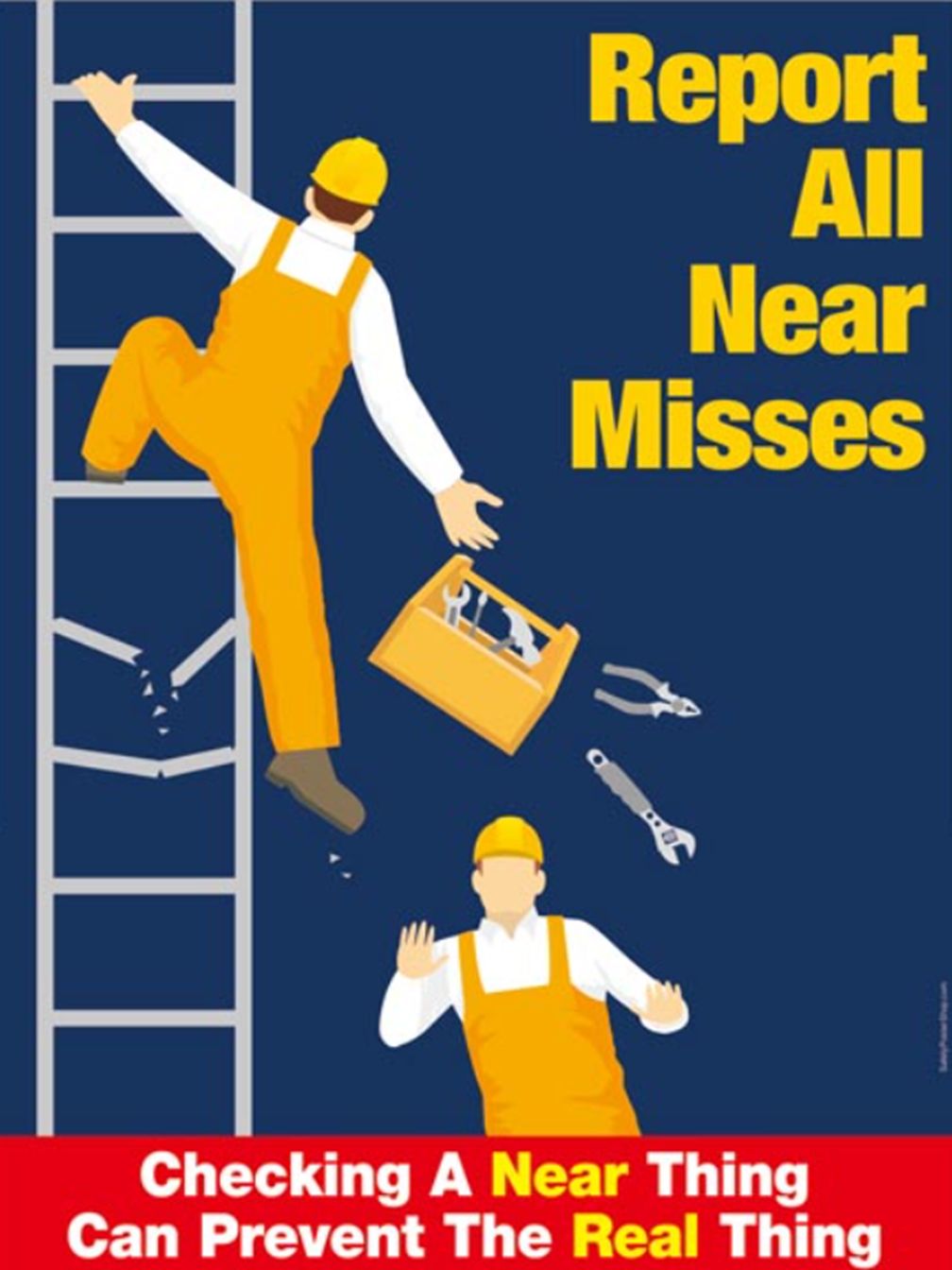

Also Read: Photo of the day: Top10 Injuries in office work
Download the Infographic
Now you can download the Infographic ” 5 Near-MIss Posters” and post them at the workplace to communicate with everyone to be familiar with Near-Miss Reporting and its benefits to avoid any injuries or incidents occurs.
Also Read: 3 New Ways To Display Signs & Posters
Photo of the day: Near-Miss 5 posters-Powerpoint
Download more resources at SAFETY BAG

More photos:
- Photo of the day: 10 Essential Safety Tips for Driving in Hot Weather Conditions
- Photo of the day: best workplace safety tips
- Photo of the day: The Importance of Stop Work Authority in Maintaining Workplace Safety
- Photo of the day: Tomorrow’s Reward for Working Safely Today: Cultivating a Culture of Safety
- Photo of the day: Preventing slips and trips at work
- Photo of the day: Learn the DRSABCD action Plan
- Working with Electricity Electrical Accidents Guide for Electrical Workers
- Photo of the day: Hearing Protection Device Selection
- Photo of the day: If An Earthquake Shakes You-Infographic free
- Fire Safety Posters Free Download
- Photo of the day: First Aid for Electrical Burns-Infographic free
- Infographic: First Aid for Cuts and Scrapes free download
- Photo of The day: Work Safe with Lasers-Laser Safety free
- Photo of the day: Working Safely with chemicals and chemical Management
- Photo of the day: Safe work practices when using MEWPs ( updated)
- Photo of the day: Preventing Common Kitchen Hazards
- Photo of the day: Safe handling of Gas Cylinders and lecture bottles
- Photo of the day: Forklift Stability Triangle
- Photo of the day: Defective Tools Safe Work Practice
- Photo of the day: Lift With Your Legs Not With Your Back
- Photo of the day: First Aid for burns
- Photo of the day: The 7 Principles of HACCP
- Photo of the day: Working Safely with Suspended Loads
- Photo of the day: Heat Stroke First Aid and safety posters
- Photo of the day: Near-Miss Reporting and Posters
- Photo of the day: Ergonomic chair and office chair safety tips
- Photo of the day: Whole Body Vibration
- Photo of the day: Substation Safety Equipment
- Photo of the day: Bypassing Safety Controls Rules
- Photo of the day: Lightning Safety Tips
- Photo of the day: Overhead Power lines Clearance
- Photo of the day: Floor Marking
- Photo of the day: Types of Foot Protection
- Photo of the day: Types of Hand Protection
- Photo of the day: Lockout and Tagout Safety
- Photo of the day: Fall Protection Plans
- Photo of the day: Flood Safety Tips
- Photo of the day: Read All Labels Work safe
- Photo of the day: Run Project safely with Crane Hand Signals
- Photo of the day: Flagman and Traffic control
- Photo of the day: Managing Risks of Exposure to Solvents in the workplace
- Photo of the day: Scissor Lift Safety
- Photo of the day: HSE Bulletin Board
- Photo of the day: Arc-Fault Circuit Interrupters (AFCI)
- Photo of the day: Safe use of ladders and step ladders
- Photo of the day: Concrete Truck Driver Hand Signals
- Photo of the day: Extension Cord Safety Tips
- Photo of the day: Protect your Head
- Photo of the day: choosing the right Anchorage
- Photo of the day: Work-Related Asthma
- Photo of the day: Top FIVE Heavy Equipment Construction Site Safety Tips
- Photo of the day: sun safety in the workplace
- Photo of the day: Cannabis and Impairment in the Workplace
- Photo of the day: Position for safety and comfort-Safety Tips
- Photo of the day: Generator Safety
- Photo of the day: Controlling COVID-19 in the Workplace-Physical Barriers
- Photo of the day: Manual Material handling
- Photo of the day: Personal Protective Equipment last resort
- Photo of the day: WHMIS 2015 – Pictograms
- Photo of the day: Indoor Air Quality
- Photo of the day: Noise in the affected workplace
- Photo of the day: Fatigue at Work
- Photo of the day: Don’t be Driven to Distraction
- Photo of the day: working in heat and Humidex Rating
- How to use Plate Clamps Safely: Safety Moment#34
- Photo of the day: Sitting at work
- Photo of the day: 5 ways to reduce the risk of Slipping and Tripping
- Photo of the day: Preventing the spread of contagious illness
- Photo of the day: Incident Investigations
- Photo of the day: 10 Scaffold Safety Essentials
- Photo of the day: Effective Health and Safety Committees
- Photo of the day: New worker Orientation & Safety Orientation checklist
- Photo of the day: Workplace Inspection
- Photo of the day: musculoskeletal disorders
- Photo of the day: Emergency preparedness in the workplace
- Photo of the day: Mental health in the workplace
- Photo of the day: Trenching Safety Tips That Can Save a Life
- Photo of the day: Dangerous Goods Classes
- Photo of the day: Safety Equipment for Confined Spaces
- Photo of the day: Tips to reduce Heat stress in the workplace
- Photo of the day: hierarchy of controls
- Your steps to chemical safety
- H2S Gas and how to handle its Emergency
- Photo of the day: Importance of Mock drill and Fire Action Emergency Procedure
- Photo of the day: Choosing the Right Face Mask and the difference between a respirator and face mask
- Photo of the day: Confined space safety Precautions
- Breath Safely: The Proper Use of Respiratory Protection
- Photo of the day: Electric shock survival
- Photo of the day: Chemical Spill Emergency Response
- Photo of the day: Construction Site fire Safety
- Photo of the day: Confined Space rescue
- Photo of the day: Conveyors Safety Tips
- Photo of the day: 5 Essential outcomes of an effective leadership survey process



